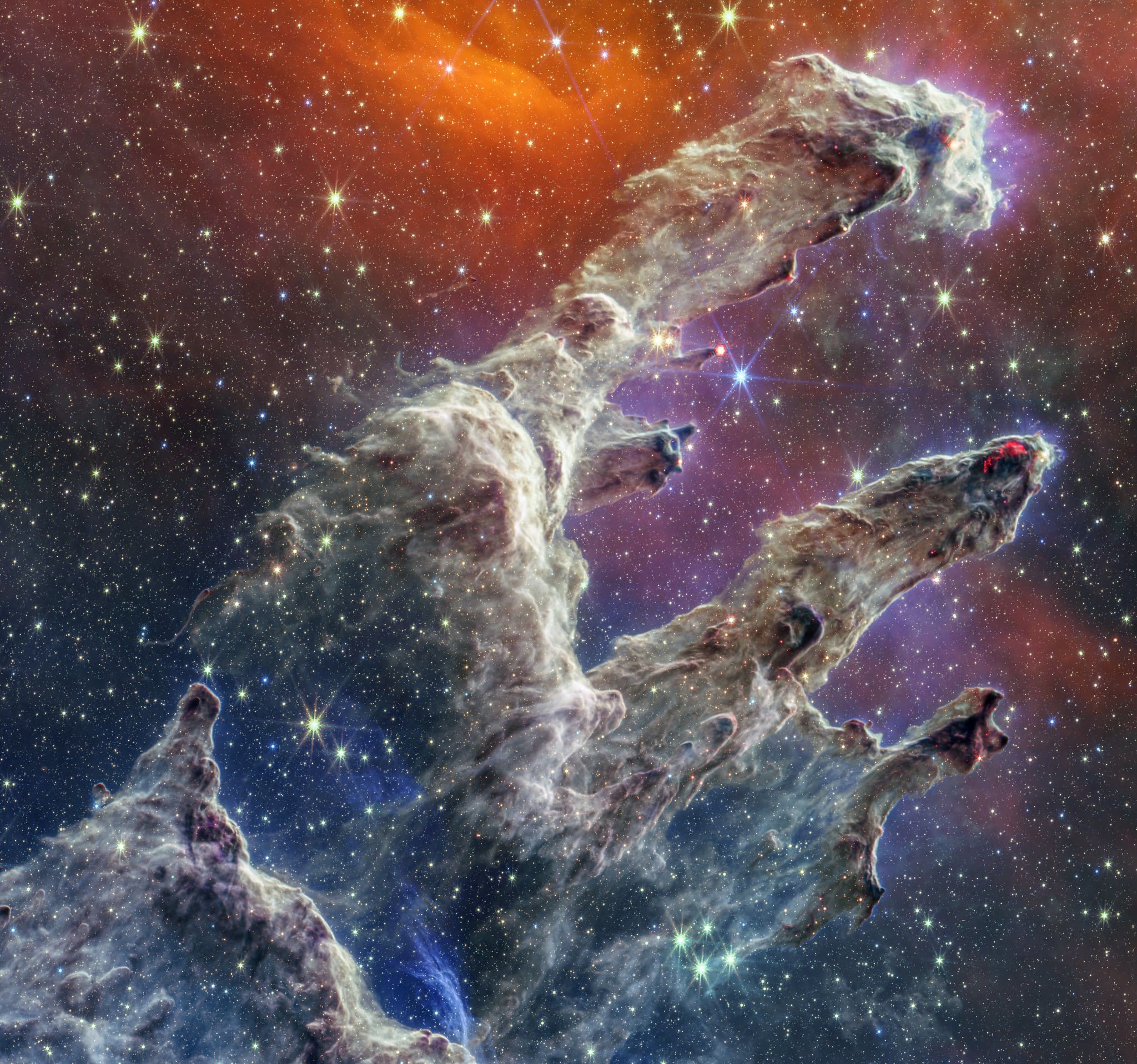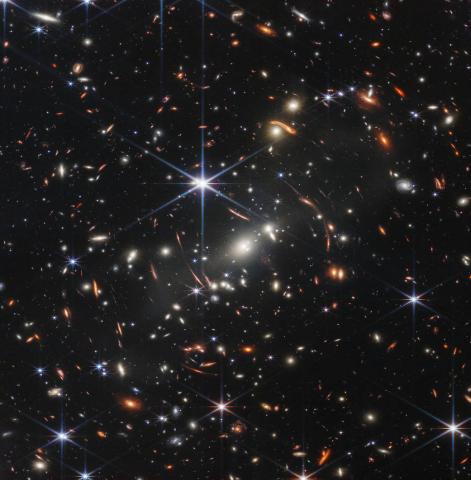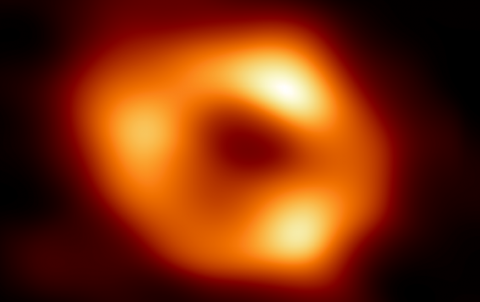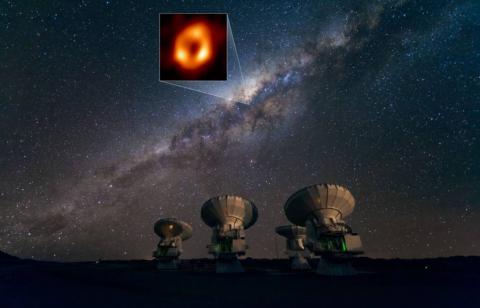Reactions: James Webb Space Telescope named 'Science' Science Breakthrough of 2022
Two decades of work with numerous setbacks, a budget of more than 10 billion dollars and a journey of 1.5 million kilometres to provide us with images of the universe in unprecedented detail have led Science magazine to choose the James Webb Space Telescope (JWST) as the science breakthrough of 2022.

The iconic 'Pillars of Creation', captured by two cameras on board the James Webb, with images in the near-infrared and mid-infrared. This star-populated area lies in the Eagle Nebula, 6,500 light-years away. Credits: NASA, ESA, CSA, STScI.
Ricardo Hueso - James Webb EN
Ricardo Hueso Alonso
Researcher at the Department of Applied Physics I and the Planetary Sciences Group of the Bilbao School of Engineering of the University of the Basque Country UPV/EHU
The selection of the James Webb Space Telescope as Science magazine's Science Milestone of the Year confirms the enormous impact this telescope is having on astronomy. Webb, three times the size of Hubble and optimised for infrared observation, has started an astronomical revolution that will extend for decades to come. With its huge budget and its decade of delays before its final launch, there was a question mark over how it would perform and what results this brand new telescope would give us. All of us who have had the good fortune to use it for observations can say that the quality of Webb's observations clearly exceeds the expectations of the international astronomical community. Since its first observations, it is fulfilling its goal of observing the light from the first galaxies and stars, which will allow cosmologists to refine the model of the expansion of the universe and to better understand why the universe is the way it is and how it works.
Webb is a multidisciplinary observatory capable of identifying as never before the components of the atmospheres of planets orbiting stars in our own galaxy, of shocking us with detailed images of the formation of stars and protoplanetary discs, of astonishing us with maps of star-forming regions, of showing us the outer structures of galaxies by tracing the effects that dark matter imprints on them through its gravity, and also of showing us the faintest, darkest and most difficult-to-explore details of the Solar System itself. Observing the Sun is the only field of astronomy that escapes its powerful gaze, and Webb's discoveries are only just beginning. Of course, this does not mean that other telescopes should be relegated, but it does mean that Webb opens a bright and wide window to our understanding of the universe.
In addition to the cosmological scales that the Webb opens up to us, it is worth mentioning on the local scale the important participation of researchers from our country who, for more than 20 years, have contributed their knowledge and talent to the development of some of the Webb's instruments, helping to make this telescope a reality, whose next and imminent discoveries we could only dream of a few years ago. Let us hope that the Webb will last for a long time and I am sure that it will surprise us with great milestones and discoveries.
Ricardo Hueso is a co-investigator in the Early Science programme of JWST 1373: "Observations of the Jovian System as a Demonstration of JWST's Capabilities for Solar System Science".
Eva Villaver - James Webb EN
Eva Villaver
Researcher at the Astrophysics Department of the Astrobiology Centre (INTA-CSIC)
The romantic image of the astronomer in solitude peering through the eyepiece of a small telescope, scrutinising the mysteries of the sky, has passed into the history of the profession. Nowadays we hardly touch telescopes; either they are too big or they are in space. Nor do we work alone. More than 20,000 people from all over the world have been involved in the project to deploy the Webb telescope 1.5 million kilometres away. It is large, international teams with lots of public funding that can build the infrastructures needed to answer the big questions: What are the planets made of? How are galaxies built? What is the furthest thing we can observe? How did the universe emerge from the dark ages to form the first stars and galaxies?
Many years go into the study and design of a telescope like JWST. And it is, in my opinion, an act of generosity for future generations and for the rest of humanity. The people who start the search for funding for such an infrastructure and with the design of the scientific experiment are often not the ones who will later work with the first data. You start today and see the first light taken by the telescope at least 20 years later.
The most powerful infrared telescope ever built is working well, better than specified for its construction, and in half a year of operation the data taken with JWST have already begun to shake the foundations of what we knew. They show us what we could not see until now and, in many cases, it is not what we expected. Such is science. In just six months it has already found the most distant galaxies, observed the impact plume generated by a human device to deflect an asteroid, or revealed the molecular and chemical profile of an extrasolar planet's atmosphere. It fascinates me to think, for example, that JWST will revolutionise our knowledge of a field of study: extrasolar planets and their atmospheres, which did not even exist when it was conceived on paper.
Javier Gómez Elvira - James Webb EN
Javier Gómez Elvira
Aeronautical engineer and former head of INTA's Department of Payloads and Space Sciences
JWST is discovering a universe that could not be seen with the Hubble telescope, as well as pushing the limits hundreds of millions of years beyond what is currently known. All this is possible thanks to the work of a group of engineers and scientists who began discussing what the JWST design should look like at the first workshop in 1989, when it was still called the Next Generation Space Telescope. These 32 years [until it was launched in December 2021] are yielding incredible results.
JWST is proving that you need to make great technological developments to get great scientific results. Technologies such as its 18 hexagonal segments deployed in space and aligned with precision are a milestone; its thermal control system using a solar radiation isolation system of more than 300 m2 and allowing the instrumentation to be at 50K or the development of electronics capable of working in cryogenic conditions. Many years of effort to develop, build and test, and thus ensure that the telescope will work as planned. Effort which, on the other hand, is already being used in other fields such as medicine or in high-precision measurement systems.
Ana Inés Gómez de Castro - James Webb EN
Ana Inés Gómez de Castro
Professor of Astrophysics and Director of the Space Astronomy Group at the Complutense University of Madrid
The James Webb Space Telescope, or JWST, has opened a new horizon for space astronomy and research into the universe. The six-metre diameter of its main mirror gives it extraordinary sensitivity and represents a technological milestone of the first magnitude. JWST has paved the way for the development of large optical structures in space such as the Large Ultraviolet Optical Infrared Explorer (LUVEX) that will characterise the atmospheres of Earth-like planets in other planetary systems. It certainly deserves its selection as "Breakthrough of the Year 2022" by Science magazine.
JWST is a NASA-led project in which the European Space Agency and the Canadian Space Agency also participate. In its first six months of life, it has obtained impressive results on the formation of stars in the early epochs of the universe, the structure of galaxies and their interaction with the intergalactic medium. JWST has made measurements of metal abundances on gas giant planets in other planetary systems and contributed to our understanding of the chemistry of the interstellar medium and protoplanetary discs.



